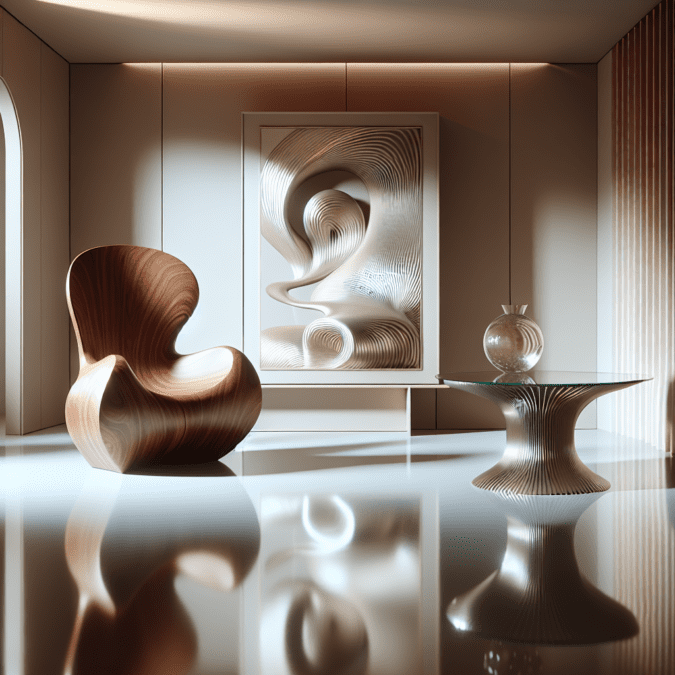Sculptural furniture pieces have been a staple of modern design for decades, pushing the boundaries of what we consider "functional" and "beautiful." These unique creations blur the lines between art and furniture, inviting us to rethink our perceptions of the objects that surround us. In this article, we’ll delve into the world of sculptural furniture, exploring its history, notable designers, and the impact it has on our daily lives.

A Brief History of Sculptural Furniture
The concept of sculptural furniture dates back to the early 20th century, when designers like Isamu Noguchi and Eileen Gray began experimenting with unconventional materials and forms. However, it wasn’t until the 1960s and 1970s that sculptural furniture gained widespread recognition. During this period, designers like Wendell Castle and Tom Wesselmann created bold, geometric pieces that challenged traditional notions of furniture design.
Notable Designers and Their Contributions
- Isamu Noguchi: A Japanese-American designer, Noguchi is known for his elegant, minimalist creations that often incorporated natural materials like wood and stone. His iconic "Coffee Table" (1948) features a sculptural base made from a single piece of wood, raising the bar for future designers.
- Eileen Gray: An Irish architect and designer, Gray was a pioneer of modernist design. Her "Dragon Chair" (1917-1919) is a masterpiece of sculptural furniture, featuring a curved, abstract form that defies traditional chair design.
- Wendell Castle: An American designer, Castle is known for his whimsical, often humorous creations that blur the line between art and furniture. His "Stool" (1969) features a stack of abstract, geometric forms that invite the user to interact with the piece.
- Tom Wesselmann: An American artist and designer, Wesselmann’s sculptural furniture pieces often incorporated bold colors and abstract forms. His "Studio Couch" (1964) features a sleek, low-profile design that redefines the concept of a sofa.
The Impact of Sculptural Furniture on Our Daily Lives
Sculptural furniture pieces have a profound impact on our daily lives, influencing the way we interact with our surroundings and perceive the objects that inhabit them. By incorporating sculptural furniture into our homes and workplaces, we can:
- Create a Sense of Wonder: Sculptural furniture pieces often evoke a sense of curiosity and fascination, inspiring us to appreciate the beauty in everyday objects.
- Encourage Interaction: Many sculptural furniture pieces invite the user to interact with them, whether through touch, movement, or contemplation. This engagement fosters a deeper connection between the user and the object.
- Define Spaces: Sculptural furniture can be used to define different areas within a room, creating a sense of spatial hierarchy and visual interest.
- Inspire Creativity: Surrounding ourselves with sculptural furniture can inspire creativity and imagination, as we begin to see the world in a new and innovative light.
FAQ
- What is sculptural furniture?
Sculptural furniture refers to unique, often abstract creations that blur the line between art and furniture. - How do I choose sculptural furniture for my home?
When selecting sculptural furniture, consider the piece’s scale, material, and color in relation to your existing decor. Ultimately, choose a piece that resonates with your personal style and aesthetic. - Is sculptural furniture comfortable?
While sculptural furniture pieces may not always prioritize comfort, many designers are now creating works that balance form and function. Look for pieces that incorporate ergonomic design and plush materials. - Can I commission a custom sculptural furniture piece?
Yes, many designers and studios offer bespoke services, allowing you to collaborate on a one-of-a-kind piece that meets your specific needs and desires.
Conclusion
Sculptural furniture pieces are a testament to human creativity and innovation, pushing the boundaries of what we consider "furniture" and inviting us to reimagine our relationships with the objects that surround us. By incorporating these unique creations into our daily lives, we can foster a deeper appreciation for art, design, and the world around us. Whether you’re a seasoned design enthusiast or simply looking to add a touch of elegance to your home, sculptural furniture is sure to inspire and delight. As we continue to evolve and push the boundaries of design, one thing is certain – sculptural furniture will remain a vital and captivating force in the world of art and design.
In the world of sculptural furniture, the possibilities are endless, and the future is bright. As we move forward, we can expect to see even more innovative and exciting designs that challenge our perceptions and inspire our imaginations. Whether you’re a designer, artist, or simply a lover of beautiful objects, sculptural furniture is sure to continue to captivate and inspire us for years to come.
Closure
Thus, we hope this article has provided valuable insights into The Art of Sculptural Furniture: Where Function Meets Form. We hope you find this article informative and beneficial. See you in our next article!